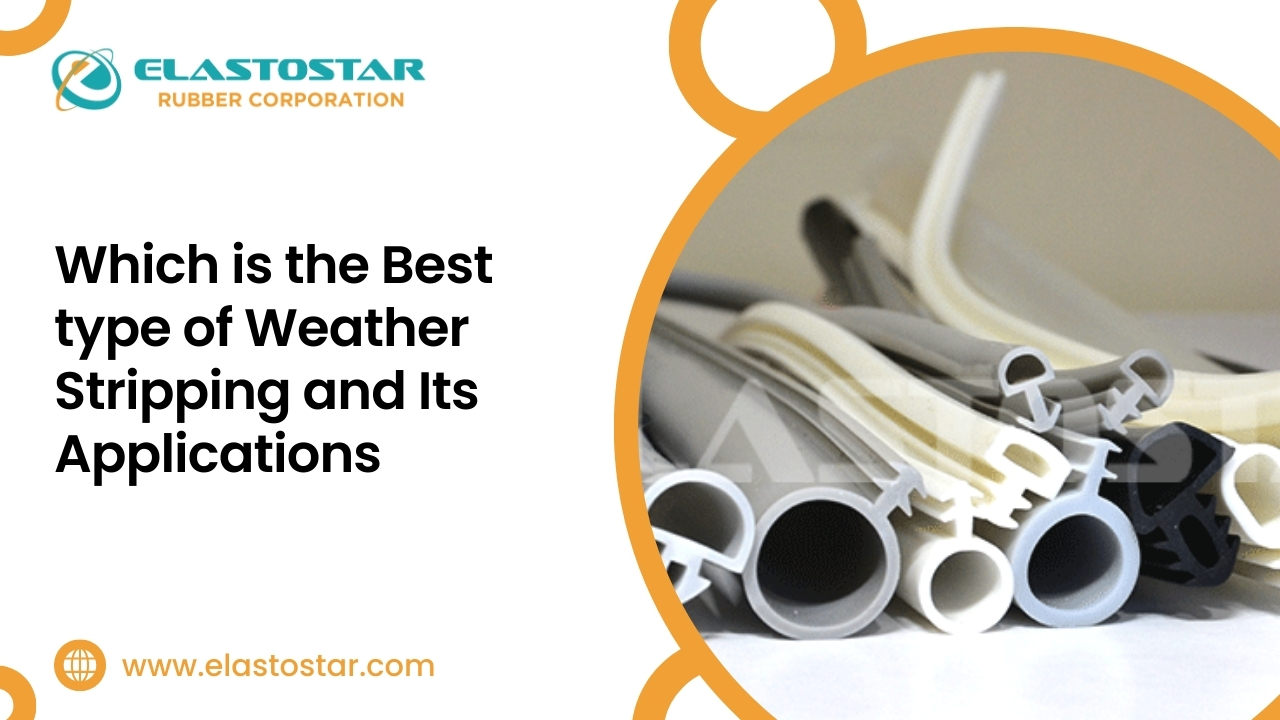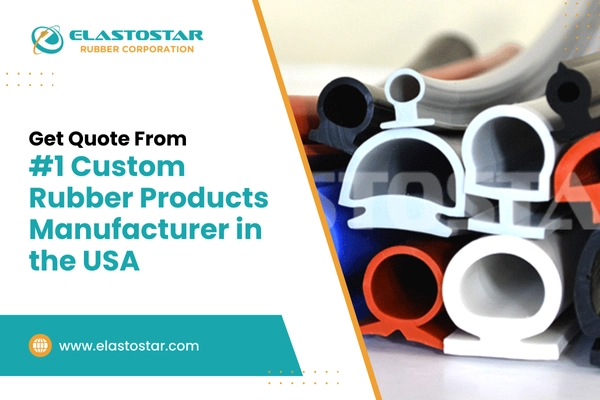When it comes to keeping your business well-insulated and energy-efficient, choosing the right weather stripping is essential. With so many options available, finding the best fit can be challenging. At Elastostar Rubber Corporation, we specialize in high-quality weather stripping solutions to meet the unique needs of any space, ensuring you get the perfect seal every time.
Let’s explore which type of weather stripping is best suited for your specific applications and how it can benefit your property.
Table of Contents
What is Weather Stripping and Why is it Important?
Weather stripping is a material used to seal the gaps around doors, windows, and other openings in a building, preventing air, moisture, dust, and noise from entering or escaping. Its primary purpose is to improve energy efficiency by minimizing the amount of heat or cool air that escapes through these gaps, helping maintain a stable indoor environment.
This not only makes homes more comfortable but also reduces energy costs by lowering the demand on heating and cooling systems.
Effective window weather stripping creates a tight weather window seal, which is crucial in preventing drafts and reducing energy loss. For example, during the winter, it keeps cold air out, while in the summer, it prevents warm air from infiltrating, thereby maintaining indoor comfort.
Similarly, front door weather stripping is for blocking drafts around entry points, protecting the interior from external elements, and contributing to overall home energy efficiency. There are various types of weather stripping materials, such as foam, rubber, vinyl, and metal, each designed to cater to specific needs and applications.
By selecting the right weather strips for your doors and windows, you can significantly enhance your residence , offices energy efficiency, comfort, and protection from the elements.
What Are the Different Types of Weather Stripping?
When it comes to choosing the right weather stripping, it’s essential to understand the different types available and their specific benefits.
1. Foam Weather Strips
Foam weather strips are popular for their ease of use and flexibility. They are a great option for front door weather stripping and window weather stripping in areas with light usage. The foam compresses easily to fill gaps and is effective in blocking drafts, but it may not be as durable in high-traffic areas.
2. Vinyl Weather Strips
Vinyl weather strips are highly durable and offer a moderate level of installation difficulty. They are particularly well-suited for sliding doors and windows, providing a secure seal that withstands regular opening and closing. These are often considered a good option for door weather stripping in frequently used areas.
3. Rubber Weather Strips
Rubber weather strips are known for their durability and resilience, making them ideal for high-traffic areas like garages. They provide an excellent seal and are effective in heavy-duty applications where a robust and long-lasting solution is required.
4. Metal Weather Strips
Metal weather strips are the most durable option, offering very high durability. Although they can be more challenging to install, they are a worthwhile investment for long-term use, especially in commercial settings or high-traffic areas where constant wear and tear is a concern.
5. Silicone Weather Strips
Silicone weather strips are the go-to choice for extreme weather conditions. They offer a high level of flexibility and can maintain their sealing properties even in very cold or hot temperatures. This makes them ideal for areas exposed to severe weather, ensuring a reliable seal throughout the year.
Also Read: 5 Benefits Of Silicone Rubber for Windows & Door Seals
| Type | Durability | Ease of Installation | Best For |
| Foam Weather Strips | Moderate | Easy | Front door weather stripping and windows with light use |
| Vinyl Weather Strips | High | Moderate | Window weather stripping and sliding doors |
| Rubber Weather Strips | High | Moderate | Heavy-duty areas, garages |
| Metal Weather Strips | Very High | Difficult | High-traffic areas, commercial use |
| Silicone Weather Strips | High | Moderate | Extreme weather conditions |
How to Install Weather Stripping for Maximum Efficiency?
Installing weather strips correctly is crucial to ensuring they provide the maximum insulation and protection.
- Measure and Cut: Start by measuring the length of the area where you will apply the weather stripping. Whether it’s a door or window, accurate measurements are key. Cut the weather strips to the correct length using a utility knife or scissors.
- Clean the Surface: Before applying the strips, make sure the surface is clean and dry. This ensures that the adhesive sticks properly, giving you a secure seal.
- Apply the Strips: Peel off the backing and press the weather strips firmly into place. For window weather stripping, make sure it aligns perfectly with the edges to create an effective weather window seal.
- Seal the Edges: Press down on the edges of the strip to ensure a tight fit. This is particularly important for commercial door weather stripping, where durability and a snug fit are essential.
- Check for Gaps: Once applied, check for any gaps or areas where the seal is not tight. Adjust as needed to ensure complete coverage.
Tips for Effective Application
- Temperature Considerations: Install weather stripping in moderate temperatures. Extreme cold or heat can affect the adhesive’s ability to bond.
- Proper Alignment: Ensure that the strips are properly aligned before pressing them into place to avoid wrinkles or gaps.
Common Mistakes to Avoid
- Skipping Surface Prep: Failing to clean the surface can lead to poor adhesion and ineffective sealing.
- Using the Wrong Type: Choose the right weather strips for the specific application. For instance, using lightweight strips on a heavily used commercial door might result in early wear.
Where Are Weather Strips Most Effective?
Silicone Rubber weather strips are crucial for maintaining comfort and efficiency in both residence and commercial spaces.
- Window Weather Stripping: Ensures a tight weather window seal, keeping drafts out and maintaining indoor temperature, which helps lower energy costs.
- Door Weather Stripping: Especially important for exterior doors, it provides a barrier against drafts, moisture, and noise, improving insulation and comfort.
- Garage Door Weather Stripping: Rubber weather stripping is ideal for sealing garage doors, effectively blocking cold air and pests.
- Commercial Applications: Metal weather strips are perfect for high-traffic areas, offering durability and maintaining energy efficiency in busy environments.
Elastostar Rubber Corporation wide range of products covers all these applications with precision, ensuring that whether you need rubber weather stripping for your garage or metal strips for a commercial space, you’ll find the perfect solution to meet your needs.
Recommended Reads
- Silicone Rubber: Where It Comes From
- Difference Between Silicone Sponge Rubber And Foam Rubber
- The Advantages Of Silicone For Rubber Products

Conclusion
Effective weather stripping is essential for maintaining energy efficiency and comfort in any space. Elastostar offers a wide range of high-quality solutions customized to various needs, whether for windows, doors, or commercial applications. By exploring our custom silicone rubber products, you can find the perfect fit for your specific requirements. If you need assistance, our expert team is ready to guide you through the selection and installation process, ensuring you get the best results for your business.
FAQs
1. What is the best type of weather stripping?
The best type of weather stripping really depends on what you need it for. Metal weather stripping is a top choice for high-traffic areas because of its durability, making it great for exterior doors. If you’re dealing with harsh weather or need something flexible for areas like garage doors, rubber weather stripping is a solid option. For lighter use, like sealing windows, foam weather stripping is easy to install and gets the job done.
2. Is rubber or foam weather stripping better?
Whether rubber or foam weather stripping is better depends on where you’re planning to use it. Rubber is more durable, making it ideal for areas like exterior doors and garages, where it needs to withstand frequent use and tough conditions. Foam, on the other hand, is easier to install and works well for sealing windows and doors in less demanding areas.
3. Which type of weather stripping is best for filling irregular spaces?
Foam weather stripping is often the go-to choice for filling irregular spaces because it’s flexible and can easily adapt to uneven surfaces, ensuring a tight seal. This makes it especially useful for older windows and doors that might not have uniform gaps. Rubber strips are also effective, particularly when you need something more durable. At Elastostar, we offer a variety of options to help you tackle these tricky areas with ease.



